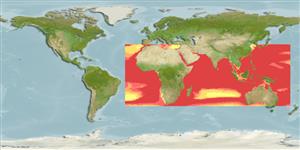Common names from other countries
Environment: milieu / climate zone / depth range / distribution range
Ekologi
; kisaran kedalaman 1 - 700 m (Ref. 110525). Tropical; 54°N - 42°S, 180°W - 180°E (Ref. 275)
Worldwide, from tropical to temperate waters.
Length at first maturity / Size / Weight / umur
Maturity: Lm ? range ? - ? cm Max length : 43.5 cm ML jantan/; (Ref. 122849); Berat maksimum terpublikasi: 0.00 g
An oceanic species that is lower epipelagic to mesopelagic and bathyal, and ranges in tropical and temperate waters of the 3 major oceans and the Mediterranean Sea. Undergoes diel vertical migration and consequently is able to regulate its bioluminescent counterillumination. As a nerito-oceanic species, occurs in association with seamounts and submarine ridges. Age and growth studies based on statolith analysis indicate a strong sexual dimorphism: males live about 1 year, females begin to mature at 1 year and spawn at about 1.5 years. Following ontogenetic descent into bathyal waters, at least to 680 m, growth rate decreases to lowest known values for squids. Relative fecundity is 200,000 to 800,000 ova, 2.6 to 1.91 mm diameter, of which 60 to 65% are spawned. Hatching occurs throughout the year; peaks November to March. Sexually mature males captured in southern African waters had nidamental glands in addition to the fully developed male reproductive system. Intersexual males were significantly larger than normal males. Preyed upon by swordfish, Xiphias gladius, lancetfish, tunas, blue shark, oceanic seabirds, Antarctic fulmar and odontocete cetaceans, e.g. sperm whales, pygmy and dwarf sperm whales, long-finned pilot whale (Ref. 97142).
Life cycle and mating behavior
Kematangan | Reproduksi, perkembang biakan | Pemijahan | telur-telur | Fecundity | Larva
Members of the class Cephalopoda are gonochoric. Male and female adults usually die shortly after spawning and brooding, respectively. Mating behavior: Males perform various displays to attract potential females for copulation. During copulation, male grasp the female and inserts the hectocotylus into the female's mantle cavity where fertilization usually occurs. Life cycle: Embryos hatch into planktonic stage and live for some time before they grow larger and take up a benthic existence as adults.
rujukan utama
Acuan | Koordinator | mitra
Roper, C.F.E., M.J. Sweeney and C.E. Nauen. 1984. (Ref. 275)
Status IUCN Red List (Ref. 130435)
status CITES (Ref. 108899)
Not Evaluated
Not Evaluated
ancaman kepada manusia
Harmless
penggunaan manusia
| FishSource |
Alat, peralatan
Sumber internet
Estimates based on models
Preferred temperature
(Ref.
115969): 11.8 - 26.5, mean 18.3 (based on 459 cells).
keancaman
Low to moderate vulnerability (29 of 100).
